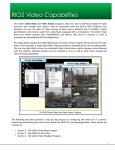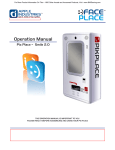Download Kyocera KR2 User's Manual
Transcript
82_R2881_1SF_Rev_001.fm Page 1 Wednesday, December 19, 2007 3:26 PM WELCOME Welcome to your Kyocera KR2 Mobile Router(KR2)! Now you can create a WiFi® hotspot, and make your network completely mobile using a EVDO enabled cellular handset or modem, or a 1xEV-DO Express Card or PC Card. A cable/DSL modem can also be used while stationary. Features • LAN Interface: WiFi® 802.11b,/g/n (highest level of security), connection speed up to 300 Mbps, 3 antennas, and 4 Ethernet ports. • Wireless Security: 64bit or 128bit WEP encryption, WPA-PSK authentication, WPS (WiFi® Protected Setup). • Connection Failover: WAN to 1xEV-DO cellular connection. • LAN Security: NAT with DHCP, PPTP VPN Pass through, MAC Filtering, IP Filtering, and Filter Scheduling. • Device Management: Web based browser for advanced users: Internet Explorer, Firefox, or other JavaScript enabled browsers. • VPN: Pass through is set by default. System Requirements • A USB cellular handset or modem, or 1xEV-DO ExpressCard, or PC Card (for a list of compatible devices please our website at: www.kyocera-wireless.com/support). • Mozilla Firefox 2.0.0.11 or later, Internet Explorer 6 or later, Netscape Navigator 9 or later, Safari 3 Beta or later, or Opera 9.24 or later. Getting to Know Your KR2 LEDs (Front View) BIENVENIDO Bienvenido al router móvil Kyocera KR2 (KR2). Ahora puede crear un punto de acceso inalámbrico (WiFi®) y añadir movilidad total a su red con un módem o teléfono celular compatible con servicios EVDO, o con una tarjeta Express Card o PC Card 1xEV-DO. También puede utilizar un cable módem o módem DSL en posiciones fijas. Características • Interfaz LAN: WiFi® 802.11b,/g/n (máximo • Seguridad LAN: NAT con DHCP, Pase VPN nivel de seguridad), velocidad de conexión de PPTP, filtrado MAC, filtrado IP y programación hasta 300 Mbps, 3 antenas y 4 puertos Ethernet. de filtrado. • Seguridad inalámbrica: Codificación WEP de • Administración de dispositivos: Navegador 64 bits o 128 bits, autenticación WPA-PSK, basado en Web para usuarios avanzados: WPS (Configuración protegida WiFi®). Internet Explorer, Firefox u otros navegadores con capacidad JavaScript. • Failover (tolerancia a fallas) en conexión: Conexión celular WAN-1xEV-DO. • VPN: De modo predeterminado se encuentra activada la función de pase. Requisitos del sistema • Un módem o teléfono celular USB, una tarjeta PC Card o ExpressCard 1xEV-DO (para obtener una lista de dispositivos compatibles, visite nuestro sitio web en: www.kyocera-wireless.com/support). • Mozilla Firefox versión 2.0.0.11 o posterior, Internet Explorer versión 6 o posterior, Netscape Navigator versión 9 o posterior, Safari versión 3 Beta o posterior u Opera versión 9.24 o posterior. Aspectos básicos del KR2 Indicadores LED (vista frontal) 5- WLAN (WiFi® is ON and operating correctly): • Green–WiFi® is enabled. • Blinking Green–WiFi® traffic is active. 6- EVDO: • Green–1xEV-DO PC Card or Express Card, 1- Power: • Green–KR2 is powered ON. (Power LED and LEDs 1-4 blink green during KR2 initialization). 2- LAN 1-4: • Green–Connected and active. 3- WAN (Wired WAN): • Green–Connected and active. 4- WPS(WiFi® Protected Setup): • Green–WPS negotiation is taking place. • Blinking Orange–WPS is in process. • Blinking Red–Session overlap or error. or USB cellular handset or modem is connected and active. • Blinking Green–WiFi® traffic is active. 7- SGNL (Signal Strength Mode): • Please see “1xEV-DO Signal Strength Monitoring” for LED mode information. Connections and Controls (Back View) 1- Alimentación: • Verde: El KR2 está encendido (posición ON). (El LED de alimentación y los LED 1-4 parpadearán en color verde durante la inicialización del KR2). 2- LAN 1-4: • Verde: Conectado y activo. 3- WAN (WAN por cable): • Verde: Conectado y activo. 4- WPS(Configuración protegida WiFi®): • Verde: Negociación WPS en curso. • Naranja parpadeante: WPS en proceso. • Rojo parpadeante: Error o superposición de sesiones. 5- WLAN (La conexión inalámbrica WiFi® está activada y funcionando correctamente): • Verde: WiFi® activada. • Verde parpadeante: Tráfico WiFi® activo. 6- EVDO: • Verde: La tarjeta PC Card o Express Card 1xEV-DO o el módem o teléfono celular USB está conectado y activo. • Verde parpadeante: Tráfico WiFi® activo. 7- SGNL (modo de potencia de la señal): • Consulte “1xEV-DO Signal Strength Monitoring” para obtener más información sobre el modo del LED. Conexiones y controles (vista posterior) 1- Power: AC Adapter Jack. 2- RESET Button: Press and hold while powering ON to initialize factory default settings. 3- USB Port 1: Data connection point for 4- WAN Port: Data connection point for hard-wired Ethernet port (cable or DSL modem). 5- LAN 1-4 Ports: Data connection point for Ethernet LAN ports (local connections). 6- Wireless ON/OFF Switch: Enables or supported handsets and modems. disables WiFi®. 1- Alimentación: Toma del adaptador de CA. 2- Botón RESET (RESTAURAR): Mantenga presionado durante el proceso de encendido para establecer los valores predeterminados de fábrica. 3- Puerto USB 1: Punto de conexión de datos para teléfonos y módems compatibles. Controls (Top View) 4- Puerto WAN: Punto de conexión de datos para puerto Ethernet cableado (cable módem o módem DSL). 5- Puertos LAN 1-4: Punto de conexión de datos para puertos LAN Ethernet (conexiones locales). 6- Interruptor de encendido/apagado (ON/OFF) de la función inalámbrica: Activa o desactiva la función WiFi®. Controles (vista superior) 1- WPS Button: Activates WiFi® Protected Setup 2- SGNL Button: Pressed at power ON to (WPS) for WPS enabled devices. monitor 1xEV-DO signal strength through LEDs 4-7. Press again to return the KR2 to normal operations. USB, Express Card, or PC Card Connection (Left Side View) • USB Port 2: Data connection point for 1xEV-DO supported handsets and modems. • Express Card Slot: Data connection point for 1xEV-DO Express Cards. • PC Card Slot: Data connection point for 1xEV-DO PC Cards. 1- Botón WPS: Activa la Configuración 2- Botón SGNL: Presione durante el proceso de Protegida WiFi® (WPS) para dispositivos con capacidad WPS. Before you Begin–Antenna Considerations encendido para monitorear la potencia de la señal 1xEV-DO mediante los LED 4-7. Presione de nuevo para regresar al modo de funcionamiento normal del KR2. Conexión USB, Express Card o PC Card (vista lateral izquierda) Antenna Location and Position Wireless signals are sensitive to interference such as walls, floors, metal objects, and other large objects. Prior to installation, locate and place the KR2 in an area of least resistance. After installing the KR2 it may be useful to adjust the antennas for maximum coverage of your work area. • Puerto USB 2: Punto de conexión de datos para teléfonos y módems compatibles con 1xEV-DO. • Ranura para tarjeta Express Card: Punto de conexión de datos para tarjetas Express Cards 1xEV-DO. • Ranura para tarjeta PC Card: Punto de conexión de datos para tarjetas PC Cards 1xEV-DO. 1xEV-DO Signal Strength Monitoring Antes de comenzar: notas acerca de la antena Caution: To ensure proper KR2 operation, please use care when positioning antennas. Ubicación y posición de la antena Low Signal Strength High Signal Strength Precaución: A fin de garantizar el funcionamiento adecuado del KR2, preste atención a la ubicación de las antenas. Las señales inalámbricas son sensibles a las interferencias ocasionadas por paredes, pisos, objetos metálicos y otros objetos de gran tamaño. Antes de la instalación, ubique el KR2 en un área donde exista una resistencia mínima. Se recomienda ajustar las antenas después de instalar el KR2 para lograr una máxima cobertura del área de trabajo. Monitoreo de la potencia de la señal 1xEV-DO Activate Signal Strength Mode: Press and hold the SGNL Button during power ON to activate SGNL Mode. Deactivate Signal Strength Mode: Press and hold the SGNL Button again to exit SGNL Mode, and return Potencia de señal baja the KR2 to normal operations. 1. Connecting Your KR2 to the Internet Potencia de señal alta There is no software to install. Simply follow the steps for your desired connection below. Wired WAN Connection (Cable Modem or DSL Modem) If using a wired WAN connection, connect through the blue wired WAN Port located on the back side of the KR2. The WAN LED will illuminate green when your network is active and connected. Para activar el modo de potencia de la señal: Mantenga presionado el botón SGNL durante el proceso 1xEV-DO Device Connection de encendido para activar el Modo SGNL. Connect your 1xEV-DO supported device through your a USB Port, Express Card Slot, or PC Card Slot. With most devices, a connection will be automatically established. The EVDO LED will illuminate green indicating your wireless network is now ready. Note: Not all cards and modems are compatible. (For a list of compatible devices please our website at: www.kyocera-wireless.com/support). Some handsets require you to change settings to allow your handset to act as a modem (consult your handset documentation for additional information). Para desactivar el modo de potencia de la señal: Mantenga presionado el botón SGNL de nuevo para salir del Modo SGNL y regresar al modo de funcionamiento normal del KR2. 2. Establishing a LAN Connection–WiFi® or Wired Conexión WAN por cable (cable módem o módem DSL) ® ® When powered ON, the KR2 serves as an active WiFi access point. Any WiFi 802.11b/g/n enabled device can associate with the KR2. Up to 32 others can associate with your wireless network (unless restricted by your cellular service provider). By default, no password is required to access network resources. Note: If using a WPS supported device you may push the WPS Button to synchronize with the KR2. KR2 WPS supports PIN and button operations. 1- KR2 SSID: Navigate to your new wireless network by selecting the KR2’s SSID (Kyocera KR2-xxx) from the list of wireless networks accessible on your computer. Note: You may also establish a wired connection to the KR2 using one of the LAN Ports. 2- Once a connection is established, open a web browser, and enter: http://192.168.0.1 into the address bar. This will take you to the KR2 Web Interface and Admin/Setup pages. 3- Enter the KR2 password. The password is the last 6 characters of the KR2’s MAC ID. This information is located on the product label (located on the bottom of the KR2). 3. Using the KR2 Setup Wizard–Establish Security After establishing a KR2 connection, navigate to the <Basic> tab of the Admin/Setup pages. From this tab you run the built in Setup Wizard to set your time zone, create your own unique password, change the network SSID (KR2 broadcast name), and establish network security. Establish Network Security: To protect your network from unauthorized users, it is highly recommended that you select one of the following wireless network security settings: • WPS: Select if your wireless device supports WiFi® protected setup. • BEST: Select if your wireless adapter supports WPA or WPA2. • GOOD: Select if your wireless adapter does not support WPA. • NONE: Select if you do not want to enable any security features. Congratulations! Your Kyocera KR2 Mobile Router setup is complete and ready for use. FACTORY RESET All settings on the KR2 will revert to their default state after a factory reset has been completed. The network name (SSID) and login password will return to their default values (located on the product label on the bottom of the KR2) Caution: Please ensure you have recorded personalized security settings before proceeding. 1- Locate the RESET Button (small hole) located on the back side of the KR2. Using the end of a paperclip, insert, press, and hold the RESET Button while simultaneously replugging in the KR2. 2- Continue holding the RESET Button until the Power LED and LEDs 1-4 blink ON and OFF. 3- Your KR2 factory settings will then be restored. SPECIFICATIONS • Operating Temperature: 32° to 122°F (0° to 50°C). • Storage Temperature: -4° to 158°F (-20° to + 70°C) • Size: 8.5 in x 5.3 in x 1.3 in (215 mm x 135 mm x 32 mm). • Weight: 0.9 lb (450 g). 1. Cómo conectar el KR2 a Internet No es necesario instalar ningún tipo de software. Sencillamente siga los pasos que se indican a continuación según la conexión que desee. Si utiliza una conexión WAN por cable, realice la conexión mediante el puerto WAN de cable azul ubicado en la parte posterior del KR2. El indicador LED WAN se iluminará en color verde cuando la red esté activa y conectada. Conexión con dispositivo 1xEV-DO Conecte el dispositivo compatible con 1xEV-DO mediante un puerto USB, ranura para tarjeta Express Card o ranura para tarjeta PC Card. Con la mayoría de los dispositivos se establecerá una conexión automáticamente. El indicador LED EVDO se iluminará en color verde cuando la red inalámbrica esté lista. Nota: No todas las tarjetas y módems son compatibles. (Para obtener una lista de dispositivos compatibles, visite nuestro sitio web en: www.kyocera-wireless.com/support). Algunos teléfonos requieren cambios en la configuración para poder utilizarlos como módems (consulte la documentación de su teléfono para obtener más información). 2. Cómo establecer una conexión LAN–WiFi® o de cable Cuando el KR2 se encuentra encendido, funciona como un punto de acceso WiFi® activo. Puede asociar cualquier dispositivo compatible con WiFi® 802.11b/g/n con el KR2. La red inalámbrica admite hasta 32 dispositivos asociados (a menos que su proveedor de servicios celulares tenga otras restricciones). De manera predeterminada, no se requiere contraseña para acceder a los recursos de la red. Nota: Si utiliza un dispositivo compatible con WPS, puede presionar el botón WPS para sincronizarlo con el KR2. La función WPS del KR2 admite operaciones de PIN y botones. 1- SSID de KR2: Para navegar hasta su nueva red inalámbrica, seleccione el identificador del Conjunto de Servicio (Service Set Identifier o SSID) del KR2 (Kyocera KR2-xxx) de la lista de redes inalámbricas accesibles desde su computadora. Nota: También puede establecer una conexión de cable al KR2 mediante uno de los puertos LAN. 2- Una vez establecida una conexión, abra un navegador web e ingrese: http://192.168.0.1 en la barra de direcciones. Se abrirán las páginas de interfaz web y Admin/Setup (administración/configuración) del KR2. 3- Ingrese la contraseña del KR2. La contraseña son los últimos 6 caracteres de la MAC ID del KR2. Esta información se encuentra en la etiqueta del producto (en la parte inferior del KR2). 3. Cómo utilizar el Asistente de configuración del KR2: nivel de seguridad Una vez establecida una conexión en el KR2, navegue hasta la ficha <Básico> de las páginas Admin/Setup. En esta ficha puede ejecutar el Asistente de configuración incorporado para determinar su zona horaria, crear su contraseña personal y única, cambiar el SSID de red (nombre de transmisión del KR2) y establecer el nivel de seguridad de red. Cómo determinar el nivel de seguridad de la red: Recomendamos elegir uno de los siguientes valores de seguridad de red inalámbrica para proteger la red de usuarios no autorizados: • WPS: Seleccione esta opción si su dispositivo inalámbrico admite la Configuración protegida WiFi®. • EL MEJOR: Seleccione esta opción si su adaptador inalámbrico admite WPA o WPA2. • BIEN: Seleccione esta opción si su adaptador inalámbrico no admite WPA. • NINGUNO: Seleccione esta opción si no desea activar ninguna función de seguridad. ¡Felicitaciones! Ha finalizado la configuración del router móvil Kyocera KR2. La unidad está lista para usar. CÓMO RESTAURAR LOS VALORES DE FÁBRICA Todas las opciones de configuración del KR2 regresarán a sus valores predeterminados de fábrica una vez completado este proceso. El nombre de red (SSID) y la contraseña de inicio de sesión regresarán a sus valores predeterminados (ubicados en la etiqueta del producto en la parte inferior del KR2). Precaución: Asegúrese de tomar nota de los valores personalizados de seguridad antes de continuar. 1- Localice el botón RESET (orificio pequeño) ubicado en la parte posterior del KR2. Inserte la punta de un sujetapapeles y mantenga presionado el botón RESET mientras enchufa el KR2. 2- Continúe presionando el botón RESET hasta que el indicador LED de alimentación y los indicadores LED 1-4 se apaguen y se enciendan intermitentemente. 3- Se restaurarán los valores predeterminados de fábrica del KR2. ESPECIFICACIONES • Temperatura de funcionamiento: entre 0° y 50°C (32º y 122ºF) • Temperatura de almacenamiento: entre -20° y 70°C (4º y 158ºF) • Tamaño: 215 mm x 135 mm x 32 mm (8.5 pulg. x 5.3 pulg. x 1.3 pulg.). • Peso: 450 g (0.9 lb). 82_R2881_1SF_Rev_001.fm Page 2 Wednesday, December 19, 2007 3:26 PM BIENVENUE Voici votre nouveau routeur mobile Kyocera (KR2)! Vous pouvez maintenant créer un point d'accès WiFi® (sans fil) et rendre votre réseau entièrement mobile grâce à un combiné cellulaire, à un modem activé EVDO ou à une carte 1xEV-DO Express ou PC. Un modem câble/DSL peut aussi être utilisé lorsque vous n'êtes pas en déplacement. Fonctions • Interface réseau local (LAN) : WiFi® 802.11b,/g/n (niveau supérieur de sécurité), vitesse de connexion jusqu'à 300 Mbit/s, 3 antennes et 4 ports Ethernet. • Sécurité sans fil : Chiffrement WEP à 64 bits ou 128 bits, authentification WPA-PSK, WPS (WiFi® Protected Setup). • Reprise de la connexion : Connexion WAN à cellulaire 1xEV-DO. • Sécurité du réseau local : Traduction d'adresse réseau avec DHCP, relais RPV pour PPTP, filtrage d'adresses MAC, filtrage d'adresses IP et planification de filtrage. • Gestion des périphériques : Navigateur Web pour les utilisateurs expérimentés : Internet Explorer, Firefox ou autres navigateurs JavaScript. • VPN : Relais établi par défaut. Configuration requise • Un combiné cellulaire ou un modem USB ou une carte 1xEV-DO ExpressCard ou PC (pour obtenir une liste des périphériques compatibles, veuillez visiter notre site Web : www.kyocera-wireless.com/support). • Mozilla Firefox 2.0.0.11 ou ultérieur, Internet Explorer 6 ou ultérieur, Netscape Navigator 9 ou ultérieur, Safari 3 Beta ou ultérieur ou Opera 9.24 ou ultérieur. Fonctionnement de votre KR2 Voyants (vue avant) 1- Alimentation : • Vert–KR2 sous tension. (Le voyant DEL d'alimentation et les DEL 1 à 4 clignotent en vert pendant l'initialisation du KR2). 2- Réseau local 1 à 4 : • Vert–Connecté et actif. 3- Réseau étendu(Réseau étendu filaire) : • Vert–Connecté et actif. 4- WPS (WiFi® Protected Setup) : • Vert–Négociation WPS en cours. • Clignotement orange–WPS en traitement. • Clignotement rouge–Superposition de session ou erreur. 5- WLAN (WiFi® est actif et fonctionne correctement): • Vert–WiFi® activé. • Clignotement vert–Trafic WiFi® actif. 6- EVDO : • Vert– Une carte 1xEV-DO PC ou Express, ou un combiné cellulaire ou un modem USB est connecté et actif. • Clignotement vert–Trafic WiFi® actif. 7- SGNL (Mode de puissance du signal) : • Veuillez consulter “1xEV-DO Signal Strength Monitoring” pour obtenir l'information sur le mode DEL. Connexions et commandes (vue arrière) 1- Alimentation : Adaptateur c.a. 2- Touche RESET (réinitialisation) : Maintenez la touche lors de la mise sous tension pour restaurer les paramètres par défaut. 3- Port USB 1 : Connexion de transfert de données pour les combinés et modems pris en charge. 4- Port du réseau étendu : Connexion de transfert de données pour port filaire Ethernet (modem câble ou DSL). 5- Ports du réseau local 1 à 4 : Connexion de transfert de données pour les ports Ethernet du réseau local (connexions locales). 6- Interrupteur d'alimentation sans fil : Active ou désactive le WiFi®. Commandes (vue du dessus) 1- Touche WPS : Active la protection WiFi® Protected Setup (WPS) pour les périphériques WPS. 2- Touche SGNL : Enfoncé à la mise sous tension pour surveiller la puissance du signal 1xEV-DO affiché par les DEL 4 à 7. Appuyer de nouveau pour ramener le KR2 à son fonctionnement normal. Connexion USB, Express Card ou PC Card (vue du côté gauche) • Port USB 2 : Connexion de transfert de données pour les combinés et modems pris en charge par 1xEV-DO . • Fente pour carte Express : Point de connexion de transfert de données pour les cartes 1xEV-DO Express. • Fente de carte PC : Point de connexion de transfert de données pour les cartes PC 1xEV-DO. Avant de commencer - Installation de l'antenne Emplacement et position de l'antenne Attention : Pour assurer le fonctionnement adéquat du KR2, veuillez positionner les antennes avec soin. Les signaux sans fil sont sensibles aux interférences causées par les murs, les planchers, les objets métalliques et d'autres objets volumineux. Avant l'installation, repérez et placez le KR2 dans un endroit présentant le moins de résistance. Après l'installation du KR2, il peut être utile d'ajuster les antennes pour obtenir la couverture optimale de votre zone de travail. Surveillance de la puissance du signal 1xEV-DO Signal faible Signal fort Activation du mode de puissance du signal : maintenez enfoncé le bouton SGNL lors de la mise sous tension pour activer le mode SGNL. Désactivation du mode de puissance du signal : maintenez enfoncé le bouton SGNL de nouveau pour quitter le mode SGNL et ramener le KR2 au fonctionnement normal. 1. Connexion de votre KR2 à Internet Il n'y a aucun logiciel à installer. Vous n'avez qu'à suivre les étapes correspondant au type de connexion souhaitée. Connexion filaire de réseau étendu (modem câble ou modem DSL) Si vous utilisez une connexion filaire de réseau étendu, raccordez le port bleu WAN situé à l'arrière du KR2. Le voyant DEL WAN passera au vert lorsque le réseau est actif et connecté. Connexion d'un périphérique 1xEV-DO Connectez votre périphérique 1xEV-DO à un port USB, une fente pour carte Express ou une fente pour carte PC. La majorité des périphériques permettent d'établir une connexion automatiquement. Le voyant EVDO passera au vert pour indiquer que le réseau sans fil est prêt. Remarque : Les cartes et les modems ne sont pas tous compatibles. Pour obtenir une liste des dispositifs compatibles, veuillez visiter notre site Web : www.kyocera-wireless.com/support. Pour certains combinés, vous devrez modifier les paramètres pour permettre au combiné de servir de modem (consultez la documentation accompagnant le combiné pour obtenir de plus amples renseignements). 2. Établissement d'une connexion au réseau local - WiFi® ou filaire Lorsqu’il est mis sous tension, le KR2 sert de point d'accès WiFi®. Tout périphérique WiFi® 802.11b/g/n peut être associé au KR2. Jusqu'à 32 autres peuvent être associés à votre réseau sans fil (à moins de restriction établie par votre fournisseur de service cellulaire). Par défaut, aucun mot de passe n'est requis pour accéder aux ressources du réseau. Remarque : Si vous utilisez un périphérique WPS, vous pouvez appuyer sur le bouton WPS pour le synchroniser au KR2. Le WPS du KR2 accepte les NIP et l'emploi des touches. 1- SSID du KR2 : Naviguez sur votre réseau sans fil en sélectionnant le SSID du KR2 (Kyocera KR2-xxx) à partir de la liste des réseaux sans fil accessibles sur votre ordinateur. Remarque : Vous pouvez aussi établir une connexion filaire au KR2 à l'aide d'un des ports du réseau local LAN. 2- Une fois la connexion établie, ouvrez un navigateur Web et tapez : http://192.168.0.1 dans la barre d'adresse. Vous accéderez à l'interface Web du KR2 et aux pages Admin/Configuration. 3- Entrez le mot de passe du KR2. Le mot de passe correspond aux 6 derniers caractères de l'ID MAC du KR2’. Cette information est affichée sur l'étiquette du produit (sous le KR2). 3. Utilisation de l'Assistant de configuration du KR2 - Établir la sécurité Après avoir établi la connexion au KR2, allez à l'onglet <Paramètres de base> des pages Admin/Configuration. À partir de cet onglet, lancez l'Assistant de configuration pour fixer la zone horaire, créer votre mot de passe, changer le SSID réseau (nom de diffusion KR2) et établir la sécurité du réseau. Établir la sécurité du réseau : Pour protéger votre réseau des utilisateurs non autorisés, il est fortement recommandé de choisir un des paramètres de sécurité du réseau sans fil suivants : • WPS : sélectionner si le périphérique sans fil prend en charge la protection WiFi®. • MEILLEUR : sélectionner si l'adaptateur sans fil prend en charge le WPA ou le WPA2. • BIEN : sélectionner si l'adaptateur sans fil ne prend pas en charge le WPA. • AUCUN : sélectionner si vous ne voulez pas activer de fonctions de sécurité. Félicitations! Votre routeur mobile KR2 de Kyocera est maintenant paramétré et prêt à être utilisé. RÉINITIALISATION COMPLÈTE Tous les paramètres du KR2 reprendront leur valeur par défaut après une réinitialisation complète. Le nom du réseau (SSID) et le mot de passe d'entrée en session reprendront leurs valeurs par défaut (apparaissant sur l'étiquette du produit, sous le KR2). Attention : Veuillez vous assurer d'inscrire les paramètres de sécurité personnalisés avant de commencer. 1- Repérez le bouton RESET (petit trou) sur l'arrière du KR2. À l'aide de l'extrémité d'un trombone, enfoncez le bouton RESET tout en rebranchant le KR2. 2- Maintenez le bouton RESET enfoncé jusqu'à ce que la DEL de mise sous tension et les DEL 1 à 4 clignotent. 3- Les paramètres par défaut du KR2 seront alors restaurés. CARACTÉRISTIQUES TECHNIQUES • Température de fonctionnement : 32° à 122°F (0° à 50°C). • Température d’entreposage : -4° à 158°F (-20° à + 70°C) • Taille: 8,5 po x 5,3 po x 1,3 po (215 mm x 135 mm x 32 mm). • Poids : 0,9 lb (450 g). Kyocera Wireless Corp Proprietary The Kyocera Wireless Corp. (“KWC”) products described in this manual may include copyrighted KWC and third party software stored in semiconductor memories or other media. Laws in the United States and other countries preserve for KWC and third party software providers certain exclusive rights for copyrighted software, such as the exclusive rights to distribute or reproduce the copyrighted software. Accordingly, any copyrighted software contained in the KWC products may not be modified, reverse engineered, distributed or reproduced in any manner not permitted by law. Furthermore, the purchase of the KWC products shall not be deemed to grant either directly or by implication, estoppel, or otherwise, any license under the copyrights, patents or patent applications of KWC or any third party software provider, except for the normal, non-exclusive royalty-free license to use that arises by operation of law in the sale of a product. Kyocera is a registered trademark of Kyocera Corporation. Cradlepoint is a trademark of Cradlepoint Technology. Macintosh is a trademark Apple Computer Inc. Netscape and Netscape Navigator are trademarks of Netscape Communications. All other trademarks are the property of their respective owners. Copyright © 2007-2008 Kyocera Wireless Corp. All rights reserved. All data and information contained in or disclosed by this document are confidential and proprietary information of Kyocera Wireless Corp, and all rights therein are expressly reserved. By accepting this material, the recipient agrees that this material and the information contained therein are held in confidence and in trust and will not be used, copied, or reproduced in whole or in part, nor its contents revealed in any manner to others without the express written permission of Kyocera Wireless Corp. Kyocera Wireless Corp. 10300 Campus Point Drive, San Diego, CA 92121 FCC Notice: This device complies with part 15 of the FCC rules. Operation is subject to the following two conditions:(1) This device may not cause harmful interference, and (2) this device must accept any interference received, including interference that may cause undesired operation. Caution: The user is cautioned that changes or modifications not expressly approved by the party responsible for compliance could void the warranty and users’ authority to operate the equipment. Note: This equipment has been tested and found to comply with the limits for a Class B digital device, pursuant to part 15 of the FCC Rules. These limits are designed to provide reasonable protection against harmful interference in a residential installation. This equipment generates, uses and can radiate radio frequency energy and, if not installed and used in accordance with the instructions, may cause harmful interference to radio communications. However, there is no guarantee that interference will not occur in a particular installation. If this equipment does cause harmful interference to radio or television reception, which can be determined by turning the equipment off and on, the user is encouraged to try to correct the interference by one or more of the following measures: • Reorient or relocate the receiving antenna. • Increase the separation between the equipment and receiver. • Connect the equipment into an outlet on a circuit different from that to which the receiver is connected. • Consult the dealer or an experienced radio/TV technician for help. Caution: To comply with the FCC RF exposure compliance requirements, this device must not be co-located or operating in conjunction with any other antenna or transmitter. Industry Canada Notice: Operation is subject to the following two conditions: (1) this device may not cause interference, and (2) this device must accept any interference, including interference that may cause undesired operation of the device. The term “IC:” before the radio certification number only signifies that Industry Canada technical specifications were met. This product meets the applicable Industry Canada technical specifications of the RSS210. This class B device complies with Canadian ICES-003. Cet appareil numérique de la classe B est confome à la norme NMB-003 du Canada. 82-R2881-1SF, Rev. 001
This document in other languages
- français: KYOCERA KR2
- español: KYOCERA KR2











